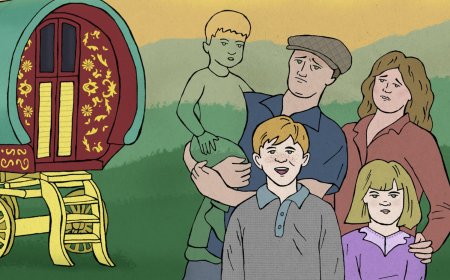SJD8 #7: Mapping 1911 New Kilmainham Ward/Inchicore: A Representation of Social Granularity in Dublin 8

This is the seventh in a series of blogs on ‘Spatial Justice in Dublin 8’ (SJD8 #7), as a contribution to Maynooth University Social Justice Week 2022.
Overview
This blog is an effort to map the social granularity of Dublin 8, in particular the New Kilmainham Ward (NKW) in 1911, with a specific focus on the area covering modern day Inchicore. Social granularity is a measure of how spatially homogenous a community is (Kearns, 2021a). In other words, it is a way of measuring the likelihood of people with different backgrounds (by class, ethnicity or both) living in close proximity with each other. ‘Fine’ social granularity would imply a community where people of different backgrounds would be equally likely to live near another person of a different background as to a person of the same background, whereas ‘coarse’ social granularity would imply the opposite. How ‘fine’ or ‘coarse’ a community is, is not a natural occurrence, but rather a political one linked to a history of inequities and interest-motivated decisions (Kearns, 2022; see also Kearns, SJD8 #2, ‘The Historical Geographies of Injustice in Dublin 8‘ and SJD8 #3, ‘The Urban Palimpsest of New Kilmainham, 1911‘).
To map social granularity, individual households need to be grouped using certain traits by which they can be considered either similar or different. Using the data available from the 1911 Census and the published census document for Dublin, I have mapped the NKW/Inchicore area along the lines of class (using the proxies of childhood mortality, literacy, and wealth) and religion. Social class and religion are two indicators of social identity in Inchicore and greater Dublin since at least 1911 (Geraghty et al., 1983; Maguire, 1993; Fernihough, et al., 2014). Geraghty et al. (1983) provide an investigation of one of the workers’ strikes that underpins the narrative of class struggles in the area at the time, a theme that we explored as part of our ‘GY607: Field School’ walks in Inchicore in 2021 (see also Whelan, SJD8 #5, ‘Inchicore as Battleground: Spatial Conflict and Dublin’s Working Class, 1902-1914‘. Fernihough et al. (2014) meanwhile highlight how interfaith marriages caused social friction for the couples, often culminating in social ostracisation and the tensions between faith groups in Ireland at the time. Meanwhile Maguire’s work (1993) describes how both religion and class affected the socio-economic status of working-class Protestants in Dublin from 1870-1926. Clearly then, analysing the area using these two broad topics allows for multiple investigations to be made.
To analyse social granularity using maps might allow spatial patterns in complex datasets to be more easily recognised (Martin, 2009). First, the questions of if and how an urban area is sorted by class will be addressed in this blog by visually creating and assessing maps along three class proxies: child mortality, household literacy, and household wealth. If we assume that the residential neighbourhoods of NKW were spatially clustered by class, such as the estates built by the Great Southern and Western Railway Company (GS&WRC) (see Keogh, SJD8#6 ‘Jobs for the Boys, a Home for the Family? Multi-generational Employment at the Inchicore Railway Works in 1911’), then they demonstrate the concept of reduced or more ‘coarse’ granularity, which may be linked to a process of ‘sorting’ the city (Kearns, 2021a; Kearns, 2021d). Second, the mapping and analysis of religion will determine if social factors other than class are at play in the sorting of NKW. If so, the question is raised about what other factors drive these groupings, and how they do so.
Another goal of the research which becomes clear when mapping households by religion is to provide an experiment for using statistically derived spatial analysis. The intent of this style of analysis is to allow for more concrete statements to be made as to the social granularity of the area, rather than to disprove the concept of a sorted city (Kearns, 2022), or to prove that the NKW is a sorted area. If successful, this approach would ideally be replicable and possibly used as standardised framework for further analysis of granularity in a population along any number of variables.
In the next section, I describe how I created proxy indicators for class and religion from the 1911 Census. I then move to analysis of the data through the creation of four maps according to each indicator. I conclude by considering how the spatial framework created in this research can be used to both qualitatively and quantitatively support the concept of the sorted city. I consider the outcomes of mapping the high-resolution data of the 1911 Census to interrogate the assumption that historic Inchicore was a monolithic working class area by looking at how households within the area arranged themselves along the lines of a second identifying feature, namely religious belief.
Methodology
Assigning social class to households based on job titles would be possible (Lawton, 1978) but beyond the scope of this project due to the scale of the data – 9000 individuals inside that area in 1911 (The National Archive of Ireland) – and the variety of value judgements required for each specific entry. Therefore, I initially used proxy indicators from the census for class, namely, child survival rates, educational attainment, and wealth. However, creating an aggregate score using these three proxies produced questionable results. In particular, too small a proportion of the households, 59%, had children, meaning the other 41% presented null values for child mortality, which would disqualify this category as a universally applicable proxy for individual household class.
However, areas with unusually high incidents of childhood mortality indicate a localised lower general level of health; similarly an area with unusually low levels of literacy indicate lower educational attainment. Meanwhile, groupings of houses with servants could indicate localised areas of relative wealth and therefore higher social class and status. The three proxies therefore do not fail as indicators of class per se, but are simply not suitable to combine as an aggregate class score. Thus, the decision was made to map and analyse them independently.
The data needed to calculate child mortality rates, or the number of children born to a couple and number of children still living, is only available for the 1911 Census (The National Archives of Ireland, 1911), which limits the scope of the research to one ‘snapshot’ in time rather than allowing for a comparison through time to see it evolve. To calculate child mortality for a household, I instead took the number of children born to a couple or widow/widower in some cases, and then divided the number of children still alive by that number. The result was expressed as a percentage per the equation below:

To calculate the child mortality for a multi-family household a second step is needed. The child mortality of each couple or sole parent in the household was averaged to give a household rate:

This calculation has an evident omission. It does not account for the age of the mother when evaluating the child mortality. A young mother had less time to see her children die, whereas the children of an older mother have spent longer exposed to the risk of dying. In future studies, taking the age of the mother as a weighted factor when calculating child survival would likely provide more accurate representations of class.
When quantifying educational attainment, I originally followed the example set out in Kearns (2021b) by using the age of the eldest scholar in a household as a proxy value. However, this did not account for families where the child was not living at the home, such as is the case for boarding students. It also does not include older demographic families whose ages were skewed past schooling age, young families with no children above the age of six or seven, or families who had a high to total rate of child mortality leaving them with few or no children in education. While I acknowledge the limitation raised by Kearns (2021b) about the accuracy of the literacy rates listed in the census, in creating a map of the social granularity of the Inchicore I nonetheless use this official metric (Registrar General of Births, Deaths and Marriages, 1911) to account for education levels for any given individual.
An important consideration when calculating household literacy is to set a cut-off age for counting a person’s literacy. It is self-evident that an infant’s ability to read or write should not affect the literacy rate of the household. Therefore, this analysis does not account for any person below the age of nine in the equations that calculate a household’s literacy score. The choice of nine years of age was to be consistent with the metrics used by the Registrar General’s office when compiling the report (1911), as seen in Table 1.

To calculate household literacy, first a value difference needed to be established between those who can neither read nor write, those who can only read, and those who can both read and write. To keep these scores in line with the other metrics, I gave those who could do both a value of 1 (fully literate), those who could only read a value of 0.5 (half literate), and those who could do neither a value of 0 (illiterate). To create a household score, I divided the sum of the individual literacy values by the number of people in the household above the age of nine:

As the census does not provide a family’s declared income, for a marker for wealth I used the presence of a live-in servant in the household. If the family were able to provide lodging, food, and wages to a person external from the family unit then that is a strong indicator for above average wealth and income. A live-in servant is defined here as a person whose ‘Relationship to the Head of the Family’ is listed as ‘Servant’ or similar on the 1911 Census Household Return (Form A) (Kearns, 2021b). The greater the number of live-in servants in a household, the greater the financial means of the household:
As a corollary to the above, using lodgers as an indicator of lower financial means could be an interesting approach. However, there is a significant difficulty presented in accurately assessing the level of difference between, say a family who has several children at home and no space for a lodger, and a family whose children have reached adulthood and have moved out to their own housing and thus have space for lodgers (see also Duff, SJD8 # 9 ‘Examining the Place of Boarders and Lodgers in Dublin 8, 1911’). Other possible scenarios are families whose children have married and whose spouse moved into the home; had it not happened, they may have desired a lodger for financial reasons. Due to the potential for calculation errors, I decided not to use this as a proxy indicator for wealth and thus class.

The cost of a servant is unknown and to give the relative wealth of households it was arbitrarily set at 1, so that the proxy of household wealth is simply the number of servants. Each additional servant multiplies the associated cost of a servants, and therefore assumed wealth of the family. This value would be more robust if it were possible to accurately assess homes that had day servants. However that data is not recorded and could therefore result in this data being less accurate in the case of a family with a great number of day servants and few to no live-in staff. It also does not account for unpaid domestic labour carried out by women, such as wives and daughters, in the household, which is a common weakness in such calculations (Drake, 1999). This does however compound the importance of the presence of domestic servants as it implies the women of the household do not have to engage in that work.
The second broad topic was to assess the breakdown of the area along the lines of religious belief, and to provide this data in an easily accessible manner. For the sake of simplicity, I have grouped the disparate Protestant denominations – Methodist, Presbyterian, and Church of Ireland – into the amalgamated group ‘Protestants’. All census individuals who registered as any form of Catholic have been classified as ‘Roman Catholics’ because though some did identify to specific churches or parishes (The National Archives of Ireland, 1911), it did not seem to be of any particular value to differentiate them along those lines. All other religions were left as separate entities, as I felt combining say Orthodox Jew with Freethinker as less representative of the granularity of a society.
Analysis
When analysing the maps focusing on the proxies for class, there are several key residential areas to consider, including the three railway company estates – The Ranch, The Bungalow, The Railway Estate – as well as Goldenbridge, and Thomas Davis St./Tyrone Place (TDS/TP), which can be seen below in the reference map Figure 1. These areas have been identified through the data and also through their specific local, historical significance (Till, 2021b; Kearns, SJD8 #3 ‘The Urban Palimpsest of New Kilmainham, 1911’).

Before moving forward with the analysis, I wish to note the parameters of this study. Firstly, the NKW maps produced for this research consist of 911 unique addresses out of a total of 1442; these were placed with relative accuracy as checked against the map provided by Kearns (2021c). (Further time with Kearns’ map would allow for the above data to be made fully accurate for the entire set of addresses.) Secondly, when accounting for the number of people in a given household, I performed a simple count on all people registered to each of the 911 unique addresses. I did not include lodgers or live-in servants, as they were not members of the family owning or in primary occupancy of the home. Including them would produce a greater possibility of skewing the results, particularly for child survival rates.
Child Mortality
In mapping child mortality of historic Inchicore, it becomes immediately evident that the rates of child mortality are quite evenly distributed (Map 2). There are certainly areas of difference: Goldenbridge and St. Joseph’s Place (just east of the Railway Estate) notably have relatively high concentrations of households with no child mortality. However, there are no stark, visible differences in mortality rates between the other areas of NKW and the three railway company estates. This is in line with the assumptions generally held about company towns and their respective residential areas where the access to essential infrastructure is generally similar (White, 2012). However, if one considers the difference between St. George’s Villas – households headed mostly by foreman (The National Archives of Ireland, 1911) – and the rest of the Railway estate, we can see that there is still a link between relative social and financial standing and general health.

Literacy
Even more so than for child mortality, NKW is largely uniform in its literacy. This is in line with the greater Dublin area (The Registrar General of Births, Deaths, and Marriages , 1911), where most of the districts inside Dublin fall under 5% illiteracy for those under 9 years of age. However, as evidenced in Map 3, The Bungalow, The Ranch, and TDS/TP residential areas contain 8%, 20% and 28% of the households below 60% literacy, and all bar one of those below 40% literacy. None of these areas contained any concentrated areas of particularly low mortality rates either, suggesting that they could be areas of lower social class more generally.

Household Wealth
Mapping the household wealth of NKW through the presence of household servants provided the most homogenous representation of the area of all three proxies, as can be seen in Map 4 below. Of the three railway company estates, only the Railway Estate had any households with servants, and all three were single servant households. From the map, a spatial divide of wealth can be broadly seen, with Tyrconnell Road forming the division. The vast majority of live-in servants present in the NKW area are in households either on Tyrconnell Road or in households to the east and Southeast of the same road. From this observation it can be argued that while the majority of the households in NKW fall into a similar working-class wealth bracket, the railway estates are the most uniformly working-class areas of the ward.

Religion
It is immediately apparent from Table 2, the two key religions in the area were Protestantism and Catholicism. Therefore, it was decided to assess if Protestants were distributed normally throughout the population, or if there is evidence of clumping that is statistically unlikely, and therefore can be attributed to outside factors such as the formation of smaller sub-communities based upon religious similarity.

From looking at the map produced (Map 5), it appears to be the case that there are localised groups of Protestant households within the mapped Inchicore area. However, the extent of the groupings of Protestant households are not immediately and explicitly obvious on the map.

A hypothesis test was performed to see if the grouping was statistically significant. To do this the actual likelihood of a given Protestant household having at least one Protestant direct neighbour was counted and the percentage of Protestant households in that group assessed:

Next, assuming a normal distribution of Protestant households in the dataset, the likelihood of a Protestant household was calculated. Using a One Sample Z Proportion Hypothesis Test the deviation between these two calculations, real likelihood and assumed likelihood, was tested for its probability in the following way:




If the deviation is statistically significant, or less than a 5% likelihood of occurring naturally, then it is evidence of other reasons for this pattern of grouping. To simplify the process, this test was performed using an online statistical significance testing tool, Epitools (Seargant, 2018). The results can be seen in Table 3.
Hypothesis Test Variables and Results Variables: Actual Likelihood 0.41 Assumed Likelihood 0.29 Population Protestants 146 Results: Significance Level 0.05 Z-Value 3.2 P-Value 0.0007
The P-Score result means that the chances of the actual likelihood calculated occurring naturally with normal distribution is 0.0007, or 0.07%, far lower than the threshold value of 5%. Therefore there is statistically significant evidence to prove this spatial pattern is the result of non-random influences. As such, I can state with relative confidence that there exists a clustering of Protestants in the NKW that is outside the statistical bounds of random chance. In other words, there exist other factors driving this reduction in granularity, which could explain the observation of the apparent disappearance of the Protestant working class in Dublin by Maguire (1993).
Conclusion
This blog has attempted to map social granularity by proxies for class and according to religion. As can be seen in Maps 3 and 4, residentialareas of significant homogeneity within NKW existed according to literacy and wealth. Further sorting according to low literacy and high child mortality were also spatially homogenous. Such spatial patterns offer strong evidence for highly sorted, coarsely-grained social groupings in terms of class. Only by child mortality was there evidence of fine granularity in the area.
As for religion, there was proof of further groupings, suggesting that that social groups were formed according to relations other than class. This significant finding opens an avenue for further research. Studying localised groupings along any number of variables may provide evidence of spatial sorting along less structurally enforced lines than company housing.
Future research might also include developing a universally applicable class score for each household, which would allow us to perform a statistical test similar to that done with religion to see if there are distinct sub-communities inside the ward. Normalising the number of rooms in each household by the population of said household would calculate population density in the household and allow for another proxy for class. Assigning the rates paid on the household might provide another proxy and perhaps allow for a better representation of the relative wealth-based stratification in the area. Another possibility would be to assign the class values from the 1911 Census to the jobs of the different household members to add further depth to their social score. Finally, this study can be expanded to include all households in the NKW 1911 Census for the area, using the newly available unpublished map of New Kilmainham from Kearns (2021c).
— Séamus Murray
Séamus Murray is a Postgraduate Diploma student in Department of Geography at Maynooth University. at Maynooth University. This blog developed from an essay written for ‘GY607: Field School’, a postgraduate module taught by Professors Till and Kearns in Semester 1, 2021.
References
Drake, M. (1999) Aspects of Domestic Service in Great Britain and Ireland, 1841–1911. Family & Community Histor, 2(2): 119-128.
Fernihough, A., O’Grada, C. & Walsh, B. (2014) Mixed Marriages in Ireland a Century Ago. [Online]. Available at: https://ssrn.com/abstract=2412147 (accessed 15 December 2021).
Geraghty, H. & Rigney, P. (1983) The Engineers’ Strike in Inchicore Railway Works, 1902. Saothar 9: 20-31.
Kearns, G. (2021a) Historical Geographies of Inchicore: Field Class 1 (15 October, held in Dublin 8). In: GY607: Field School (with K. Till), Department of Geography: Maynooth University, Semester 1, 2021.
Kearns, G., 2021b. Working with Enumerators’ Books. Unpublished report for students in: GY607: Field School, Department of Geography: Maynooth University, Semester 1, 2021.
Kearns, G., 2021c. Map of New Kilmainham Ward Addresses, 1911. [Unpublished document].
Kearns, G., 2022. Sorting the City In: Phelan, G. ed. There Are Better Ways: Education, Class and Free Thought FM. Dublin: Douglas Hyde Gallery of Contemporary Art. 58–67. Available at: http://www.garrettphelan.com/FreeThoughtFM.html (accessed 16 March 2022).
Lawton, R. (1978) The Census and Social Structure: An Interpretative Guide to Nineteenth Century Censuses for England and Wales. London: F. Cass.
Maguire, M. (1993) A Socio-Economic Analysis of the Dublin Protestant Working-Class 1870-1926. Irish Economic and Social History 20(January): 35-61.
Martin, D. (2009) Census Mapping In: Thrift, N. and Kitchin, R. eds. International Encyclopedia of Human Geography. Southampton: Elsevier: 12-17.
Registrar General of Births, Deaths and Marriages (1911). Census of Ireland, 1911: Area, Houses, and Population; The Ages, Civil or Conjugal Condition, Occupations, Birthplaces, Religion, and Education of the People. Province of Leinster: City of Dublin. Available National Archives of Ireland: http://www.census.nationalarchives.ie/ (accessed 15 December 2021).
Seargant, ESG | Ausvet, 2018. Epitools Epidemiological Calculators. [Online] Available at: http://epitools.ausvet.com.au (accessed 15 November 2021).
SmartMonkey, 2015. Google Workspace Marketplace | Geocoding by Smartmonkey. [Online] Available at: https://workspace.google.com/marketplace/app/geocoding_by_smartmonkey/1033231575312 (accessed 1 November 2021).
The National Archives of Ireland (1911). The National Archives of Ireland Census Year 1911 Dublin. [Online] Available at: http://census.nationalarchives.ie/pages/1911/Dublin/New_Kilmainham/ (accessed 16 October 2021).
Till, K. (2021a) Field Class 2: Place, Social Memory, and Landscape Iconography. Assignment Overview and Guidelines. In: GY607: Field School (with G. Kearns), Department of Geography: Maynooth University, Semester 1, 2021.
Till, K. (2021b) Inchicore as Palimpsest. Week 2 Lecture Slides. In: GY607: Field School (with G. Kearns), Department of Geography: Maynooth University, Semester 1, 2021.
Ward, D. (1980) Environs and Neighbours in the “Two Nations”: Residential Differentiation in mid-nineteenth-century Leeds. Journal of Historical Geography 6(2): 133-162.
White, N. (2012) Company Towns: Corporate Order and Community. Toronto: University of Toronto Press.










































